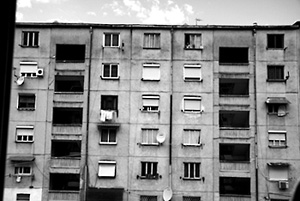Princeton University
Princeton Weekly Bulletin March 12, 2007, Vol. 96, No. 19 prev next current
- Page One
- • Testing the boundaries of teaching science
- • Harris-Lacewell draws on intellectual prowess and common sense
- Inside
- • Energy plant wins award for reducing pollution and improving efficiency
- • Film about senior thesis performance earns honors
- • Students turn class into effort to help New Orleans rebuild
- • Exhibition, panel to document socialist architecture in Eastern Europe
- People
- • Spotlight
- Almanac
- • Calendar of events
- • Nassau notes
- • By the numbers
- The Bulletin is published weekly during the academic year, except during University breaks and exam weeks, by the Office of Communications. Second class postage paid at Princeton. Postmaster: Send address changes to Princeton Weekly Bulletin, Office of Communications, Princeton University, 22 Chambers St., Suite 201, Princeton, NJ 08542. Permission is given to adapt, reprint or excerpt material from the Bulletin for use in other media.
- Subscriptions. The Bulletin is distributed free to faculty, staff and students. Others may subscribe to the Bulletin for $30 for the 2006-07 academic year (half price for current Princeton parents and people over 65). Send a check to Office of Communications, Princeton University, 22 Chambers St., Suite 201, Princeton, NJ 08542.
- Deadlines. In general, the copy deadline for each issue is the Friday 10 days in advance of the Monday cover date. The deadline for the Bulletin that covers March 26-April 1 is Friday, March 16. A complete publication schedule is available at www.princeton.edu/ pr/ pwb/ deadlines.html; or by calling (609) 258-3601.
- Editor: Ruth Stevens Calendar editor: Shani Hilton Staff writers: Jennifer Greenstein Altmann, Eric Quiñones Contributing writers: Ushma Patel Photographers: Denise Applewhite, John Jameson Design: Maggie Westergaard Web edition: Mahlon Lovett
Exhibition, panel to document socialist architecture in Eastern Europe


During the latter half of the 20th century, Eastern European architects constructed many thousands of prefabricated concrete buildings in an effort to provide modern housing. Graduate student Elidor Mehilli’s upcoming photographic exhibition chronicles the buildings’ often drab exteriors as well as his hometown of Tirana, Albania’s recent program to paint them with bold colors.
Princeton NJ — Though the Iron Curtain no longer exists, the innumerable prefabricated concrete buildings that sprang up behind it still provide homes and workplaces for many millions of Eastern Europeans. This architectural legacy will be explored in a photographic exhibition that opens Monday, March 12, and a panel discussion the next day in the Woodrow Wilson School of Public and International Affairs.
The exhibition, “After Utopia,” will be on view in Robertson Hall’s Bernstein Gallery. It will feature the photographs of Elidor Mehilli, who is focusing on this period of architectural history as part of his Ph.D. research. His work has inspired several Princeton faculty members to offer a panel discussion of the photos titled “After Utopia: The Landscape of Socialist Cities” at 4:30 p.m. Tuesday, March 13, in 16 Robertson Hall.
“The exhibition explores the ruins of ‘socialist cities’ that sprang up after World War II,” Mehilli said. “This style of construction appears garish, but it is still a big part of people’s lives across Russia and Eastern Europe, and will likely remain the most viable housing option for them for decades. Dealing with these buildings is going to be a public policy issue in this part of the world for the foreseeable future.”
Panel organizer Stanley Katz said he hoped the open-ended discussion would help orient viewers to the photos’ artistic and social dimensions.
“The historical period that produced these buildings is rapidly becoming something unfamiliar to young people in this country,” said Katz, a lecturer with the rank of professor in the Wilson School and chair of the Bernstein Gallery Committee. “We would like to marry serious concern for the art to a serious discussion of these buildings’ social context.”
Other participants in the discussion, which is co-sponsored by the Davis Center for Historical Studies, will include: Gyan Prakash, the Dayton-Stockton Professor of History and director of the Davis Center; Stephen Kotkin, professor of history and director of the Program in Russian and Eurasian Studies; and Christine Boyer, the William R. Kenan Jr. Professor of Architecture and director of the Program in Urban Studies.
Soviet planners of the early 1950s created the architectural style, which was then exported across Eastern Europe. At the time, the damage World War II had inflicted on the region left great demand for housing but few ways to provide it quickly and effectively.
Though the gray concrete buildings are often described as bleak, Mehilli explained that for many Eastern Europeans, they represented the only viable way to provide electricity and heat to the population in the years following the war.
“The economic need to house the population dominated all other concerns,” he said. “Aesthetics did not come first.”
Each wall of the exhibition will feature photographs dedicated to a different theme. One will feature photos of Tirana, the Albanian capital, whose current mayor recently engaged in a campaign to paint the buildings in bright colors in an effort to escape from the grayness of the city’s fabric.
Mehilli’s interest in socialist-era architecture was partly inspired by his childhood in Albania, and the photos are primarily of his homeland, though some are from his travels to East Berlin and Sarajevo.
“I took some of these shots from the windows of my parents’ apartment in Tirana,” Mehilli said. “This work springs partially from my personal history, so I wanted to make it a bit more intimate.”
A second-year graduate student in modern European history, Mehilli earned his bachelor’s degree from Cornell University.
The exhibition runs through Friday, April 27. Hours are 9 a.m. to 5 p.m.

